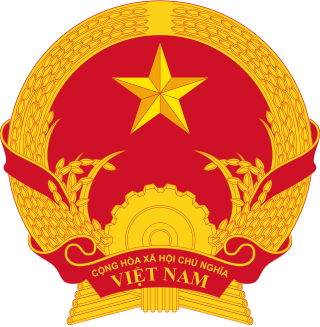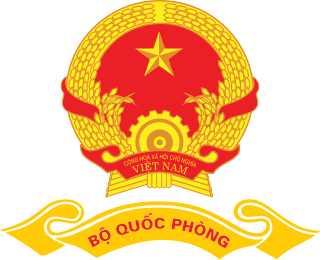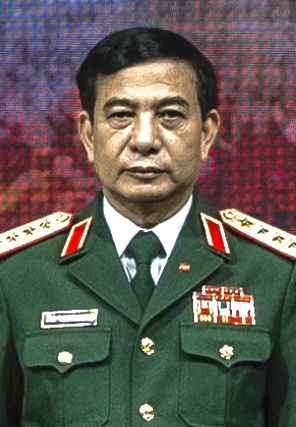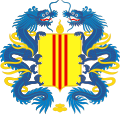
The People's Army of Vietnam (PAVN), officially the Vietnam People's Army, also recognized as the Vietnamese Army or the People's Army, is the national military force of the Socialist Republic of Vietnam and the armed wing of the ruling Communist Party of Vietnam (CPV). The PAVN is a part of the Vietnam People's Armed Forces and includes: Ground Force, Navy, Air Force, Border Guard and Coast Guard. Vietnam does not have a separate Ground Force or Army service. All ground troops, army corps, military districts and special forces belong to the Ministry of National Defence, directly under the command of the CPV Central Military Commission, the Minister of National Defence, and the General Staff of the Vietnam People's Army. The military flag of the PAVN is the National flag of the Socialist Republic of Vietnam defaced with the motto Quyết thắng added in yellow at the top left.

Phạm Văn Đồng was a Vietnamese politician who served as Prime Minister of North Vietnam from 1955 to 1976. He later served as Prime Minister of Vietnam, following reunification of North and South Vietnam, from 1976 until he retired in 1987 under the presidency of Lê Duẩn and Nguyễn Văn Linh. He was considered one of Hồ Chí Minh's closest lieutenants.

Robert Strange McNamara was an American businessman and government official who served as the eighth United States secretary of defense from 1961 to 1968 under presidents John F. Kennedy and Lyndon B. Johnson. He remains the longest-serving secretary of defense, having remained in office over seven years. He played a major role in promoting the U.S.'s involvement in the Vietnam War. McNamara was responsible for the institution of systems analysis in public policy, which developed into the discipline known today as policy analysis.

The president of the Socialist Republic of Vietnam is the head of state of Vietnam, elected by the National Assembly of Vietnam from delegates of the National Assembly. Since Vietnam is a single-party state, the president is generally considered to hold the second highest position in the political system, practically after the general secretary of the Communist Party of Vietnam. In addition, the president appoints the head of government, the prime minister. As head of state, the President represents Vietnam both domestically and internationally, and maintains the regular and coordinated operation and stability of the national government and safeguards the independence and territorial integrity of the country.

The Southeast Asia Treaty Organization (SEATO) was an international organization for collective defense in Southeast Asia created by the Southeast Asia Collective Defense Treaty signed in September 1954 in Manila, Philippines. The formal institution of SEATO was established on 19 February 1955 at a meeting of treaty partners in Bangkok, Thailand. The organization's headquarters was also in Bangkok. Eight members joined the organization.

Phan Huy Quát was a South Vietnamese doctor and politician who served as Prime Minister of the Republic of Vietnam for four months in 1965.

Nguyễn Văn Vy was a South Vietnamese soldier who rose to the rank of lieutenant general in the Army of the Republic of Vietnam (ARVN). In addition to his military career, he served as Minister of National Defense of the Republic of Vietnam from 1967 to 1972.

The Vietnam People's Armed Forces are the armed uniformed services and national security forces of the Socialist Republic of Vietnam. Being placed under the political leadership of the sole-ruling Communist Party of Vietnam and theoretically under the supreme command of the President of Vietnam, it consists of three components: the People's Army of Vietnam which is the military of Vietnam, Vietnam People's Public Security which is the law enforcement agency of Vietnam and Vietnam Militia and Self-Defence Force which is the militia of Vietnam.
The Battle of Trà Bình was fought in the Trà Bình village, Trà Bồng District, on February 14–15, 1967 during the Vietnam War. The 11th Company, 3rd Battalion, 2nd Marine Brigade defeated a regimental-sized attack in four hours of close quarters combat. The People's Army of Vietnam (PAVN) and Viet Cong (VC) penetrated the company's perimeter on two occasions. The 11th Company Marines fought using every weapon available; much of the fighting was hand-to-hand. Two U.S. Marines assigned to Sub Unit One, 1st Air Naval Gunfire Liaison Company (ANGLICO), Lance Corporals Jim Porta and Dave Long, were instrumental to the company's success, killing enemy infiltrators, coordinating air support, joining a counterattack to restore the perimeter and aiding the wounded.

A ministry of defence or defense, also known as a department of defence or defense, is the part of a government responsible for matters of defence and military forces, found in states where the government is divided into ministries or departments. Such a department usually includes all branches of the military, and is usually controlled by a defence minister, or secretary of defense.

Cao Văn Viên was one of only two South Vietnamese four-star army generals in the history of the Army of the Republic of Vietnam during the Vietnam War. He rose to the position of Chairman of the South Vietnamese Joint General Staff. Considered one of "the most gifted" of South Vietnam's military leaders, he was previously called an "absolute key figure" and one of "the most important Vietnamese military leaders" in the U.S.-led fighting during the Vietnam War. Along with Trần Thiện Khiêm he was one of only two four-star generals in the entire history of South Vietnam.

The Ministry of National Defence, alternatively the Ministry of Defence (MoD), fully the Ministry of Defence of the Socialist Republic of Vietnam, is the governmental ministry of the Socialist Republic of Vietnam that manages, coordinates and supervises military affairs, including all military units, paramilitary units, and similar agencies in the country. The major office of the Ministry of National Defence is located within the ancient Hanoi Citadel. The ministry is operated in compliance with the Constitution and Laws of the Socialist Republic of Vietnam, ideologically under the leadership of the Communist Party of Vietnam and the unified State management of the Vietnamese Government. It runs the People's Army Newspaper and the Military Broadcasting Center together with the Central Military Commission of the Communist Party of Vietnam. Besides press and media agencies, the Ministry of National Defence also owns and administers a number of enterprises, noticeably the Viettel Military Industry and Telecoms Group besides many core businesses of the Vietnamese defence industry.

The Minister of Defence is the Government of Vietnam member in charge of the Ministry of Defence. The Minister directs the management functions of state for defense, and is responsible for and is the second highest commander of the Vietnam People's Army and Militia. The Minister is also Vice Chairman of the Central Military Commission, a Member of the Politburo and a Member of the Council for National Defense and Security. The current Minister of Defence is Army General Phan Văn Giang, since 8 April 2021.

Nguyễn Đình Thuần was the Secretary of State under President Ngô Đình Diệm of South Vietnam. After Ngô Đình Diệm was overthrown and then killed in the 1963 South Vietnamese coup, Nguyễn Đình Thuần moved to France to live with his brother.
The National Defense and Security Council is an agency of the Socialist Republic of Vietnam, tasked with overseeing the defence and security of the country during a state of emergency or war.
The 1964 Laotian coups were two attempted coup d'etats against the Royal Lao Government. The 18 April 1964 coup was notable for being committed by the policemen of the Directorate of National Coordination. Although successful, it was overturned five days later by U.S. Ambassador Leonard Unger. In its wake, Neutralist Prime Minister Souvanna Phouma forged a fragile coalition with the Pathet Lao communists. On 4 August 1964, Defense Minister Phoumi Nosavan attempted to take over Vientiane with a training battalion. This coup was quickly crushed by the local Royal Lao Army troops, as the police sat out the conflict.

The minister of foreign affairs is the Government of Vietnam member in charge of the Ministry of Foreign Affairs. Moreover, member of Council for National Defense and Security. Since 2007, the minister of foreign affairs served as Deputy Prime Minister and member of the Politburo. However, Hoàng Minh Giám, Ung Văn Khiêm, Xuân Thủy, Nguyễn Dy Niên are not the member of Politburo. The current Vietnamese minister of foreign affairs is Bùi Thanh Sơn.

The Chief of the General Staff is the chief of staff of the General Staff of the People's Army of Vietnam. The Chief of the General Staff performs the task of advising the Minister of Defense in terms of state management and military command. The Chief of the General Staff also serves ex officio as Standing Deputy Minister of Defense. He is appointed by the President of Vietnam, who is the Commander-in-Chief. The current Chief of the General Staff is Colonel General Nguyễn Tân Cương




























